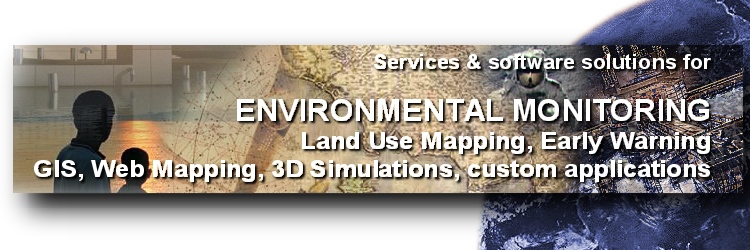|
Early Warning and Risk Analysis tool, analysis of vegetation
indices, multi-temporal analysis of time series, calculation of the
baseline, comparison of the current situation compared to the average
for each period, creating maps of synthesis, graphics, drafting synoptic
bulletins.
The system integrates a MONITORING TOOL and, based on it, a
EARLY WARNING / RISK ANALYSIS TOOL
MONITORING TOOL
By this service, it is possible to track variations of vegetation and
generic surface conditions with reference to HOMOGENEOUS AREAS
(VI segments, areas where there are constant temporal dynamics of a
Vegetation Index).
BASIC DATA
This system provides an objective measure of the evolution in time,
space and "value" of the same VEGETATION INDICES. The Vegetation Indices
can be selected from available and validated data sources:
- MODIS EVI
- MODIS PVI
- MODIS NDVI
- SPOT VEG EVI
- SPOT VEG PVI
- SPOT VEG NDVI
- ...
With this approach, the Analysts may use the same variable as input
and as reference base for the monitoring process. In the case of
remote sensing data the variable used is a VI.
HOW IT WORKS
The Monitoring action is implemented by comparing current conditions
(near-to-real-time) with long term averages of an analysis of the
cause-effects supported by ancillary (static and dynamic) data in the
form of digital maps, meteorological historic records, field reports,
and other local information sources.
Then the System allows a near-to-real-time quantitative and qualitative
analysis of agricultural and, in general, of vegetation conditions.
The term CONDITIONS refers specifically to:
- the status (health/crop phonological development) of the vegetation
cover (crops/pasture/rangeland)
- the effects/consequences of contingency represented by exceptional
events like drought, storms, fire, pests and other environmental
hazards
KEY FACTORS
- The use of reference homogeneous areas (VI segments) increases
the local "significance" and sensitivity to anomalous events
- The analysis over single independent VI segment allows the achievement
of a locally specific measure
- The measure reference scale is unique across territories that
are different by land use/land cover and surface altitude pattern.
This criteria of analysis allows the identification of systematic
outlier areas and blind spots to remote sensing
EARLY WARNING / RISK ANALYSIS TOOL
The Early Warning Tool integrates the Monitoring Tool using statistically
based thresholds of anomalies on the VI segments. The term
ANOMALIES refers to the a number of events that can be identified
by comparing the current value of a VI and the reference value of a
VI segment at the moment of analysis: ABSOLUTE DIFFERENCES,
RETURN PERIOD OF SIMILAR ANOMALIES/FREQUENCY.
The System is (can be) based on multiple data sources even though is
driven essentially by Remote Sensing data.
Operating within a GIS, the Early Warning and Monitoring Tools associate
the Analysis with Ancillary data in order to:
- Explain the QUANTITATIVE INDICATORS of anomaly
- Supplement the indicators
- Integrate the indicators
- Replace the indicators in case of missing data or "blind" spots to remote sensing data
The Vegetation Indices and Ancillary Data are selected from available
and validated data sources.
The Analysis procedure is customized on the requirements and capacity
of identified Information providers.
The Output of the System is provided in the form of bulletins providing
objective (eg. Map and tables) and narrative information.
Outputs are customized on the requirements of identified decision makers.
| 


